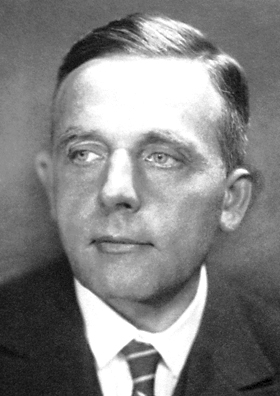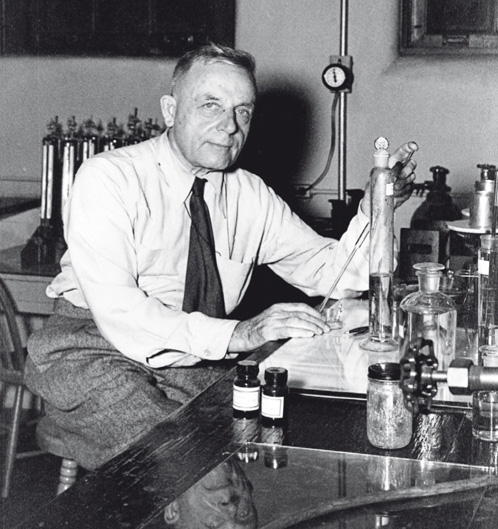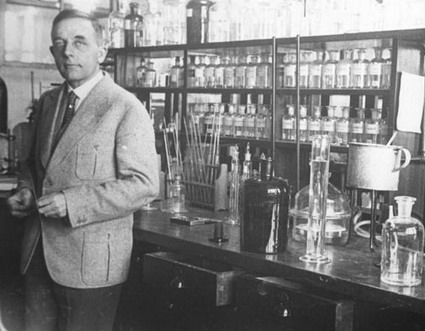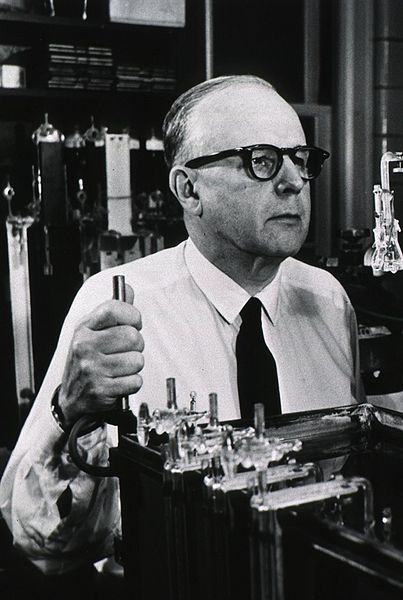<Back to Index>
- Physiologist and Physician Otto Heinrich Warburg, 1883
- Biochemist Dean Burk, 1904
PAGE SPONSOR


Otto Heinrich Warburg (October 8, 1883, Freiburg im Breisgau – August 1, 1970, Berlin), son of physicist Emil Warburg, was a German physiologist, medical doctor and Nobel laureate. He served as an officer in the elite Uhlan (cavalry regiment) during the First World War and won the Iron Cross (1st Class) for bravery. Warburg was one of the twentieth century's leading biochemists. He won the Nobel Prize of 1931 (and in total, he was nominated three times for the Nobel prize for three separate achievements).
Warburg's father, Emil Warburg, was a member of the illustrious Warburg family of Altona, who had converted to Christianity reportedly after a disagreement with his Conservative Jewish parents. Emil was also President of the Physikalische Reichsanstalt, Wirklicher Geheimer Oberregierungsrat (literally, "True Senior Privy Counselor"). Warburg's mother was the daughter of a Protestant family of bankers and civil servants from Baden.
Warburg studied chemistry under the great Emil Fischer, and earned his Doctorate of Chemistry in Berlin in 1906. He then studied under Ludolf von Krehl, and earned the degree of Doctor of Medicine in Heidelberg in 1911.
Between 1908 and 1914, Warburg was affiliated with the Naples Marine Biological Station, also known as the Stazione Zoologica, in Naples, Italy, where he conducted research. In later years he would return for visits, and maintained a lifelong friendship with the family of the station's director.
A lifelong equestrian, he served as an officer in the elite Uhlans (cavalry) on the front during the First World War where he won the Iron Cross.
Warburg later credited this experience with affording him invaluable
insights into "real life" outside the confines of academia. Towards the
end of the war, when the outcome was unmistakable, Albert Einstein,
who had been a friend of Warburg's father Emil, wrote Warburg at the
behest of friends, asking him to leave the army and return to academia,
since it would be a tragedy for the world to lose his talents. Einstein
and Warburg later became friends, and Einstein's work in physics had
great influence on Otto's biochemical research.
While working at the Marine Biological Station, Warburg performed research on oxygen consumption in sea urchin eggs after fertilization, and proved that upon fertilization, the rate of respiration increases by as much as sixfold. His experiments also proved that iron is essential for the development of the larval stage.
In 1918 Warburg was appointed Professor at the Kaiser Wilhelm Institute for Biology in Berlin - Dahlem (part of the Kaiser - Wilhelm - Gesellschaft). By 1931 he was named Director of the Kaiser Wilhelm Institute for Cell Physiology there, which was founded the previous year by a donation of the Rockefeller Foundation to the Kaiser Wilhelm Gesellschaft (since renamed the Max Planck Society).
Warburg investigated the metabolism of tumors and the respiration of cells, particularly cancer cells, and in 1931 was awarded the Nobel Prize in Physiology for his "discovery of the nature and mode of action of the respiratory enzyme." The award came after receiving 46 nominations over a period of nine years beginning in 1923, 13 of which were submitted in 1931, the year he won the prize.
In 1944, Warburg was nominated for a second Nobel Prize in Physiology by Albert Szent - Györgyi, for his work on nicotinamide, the mechanism and enzymes involved in fermentation, and the discovery of flavine (in yellow enzymes). It is reported by some sources that he was selected to receive the award that year but was prevented from receiving it by Adolf Hitler’s regime, which had issued a decree in 1937 that forbade Germans from accepting Nobel Prizes. According to the Nobel Foundation, this rumor is not true; although he was considered a worthwhile candidate, he was not selected for the prize.
Three scientists who worked in Warburg's lab, including Sir Hans Adolf Krebs, went on to win the Nobel Prize. Among other discoveries, Krebs is credited with the identification of the citric acid cycle (or Szentgyörgyi - Krebs cycle).
In 1924, Warburg hypothesized that cancer, malignant growth, and tumor growth are caused by the fact that tumor cells mainly generate energy (as, e.g., adenosine triphosphate / ATP) by non - oxidative breakdown of glucose (a process called glycolysis) and the subsequent recycling of the metabolite NADH back to its oxidized form, for reuse in the glycolytic cycle to complete the process (known as fermentation, or anaerobic respiration). This is in contrast to "healthy" cells which mainly generate energy from oxidative breakdown of pyruvate. Pyruvate is an end - product of glycolysis, and is oxidized within the mitochondria. Hence, and according to Warburg, cancer should be interpreted as a mitochondrial dysfunction.
"Cancer, above all other diseases, has countless secondary causes. But, even for cancer, there is only one prime cause. Summarized in a few words, the prime cause of cancer is the replacement of the respiration of oxygen in normal body cells by a fermentation of sugar." -- Dr. Otto H. Warburg in Lecture
Warburg continued to develop the hypothesis experimentally, and held several prominent lectures outlining the theory and the data.
The
concept that cancer cells switch to fermentation in lieu of aerobic
respiration has become widely accepted, even if it is not seen as the cause of cancer. Some suggest that the Warburg phenomenon could be used to develop anticancer drugs. Meanwhile, cancer cell glycolysis is the basis of positron emission tomography (18 - FDG PET), a medical imaging technology that relies on this phenomenon.
Otto Warburg edited and has much of his original work published in The Metabolism of Tumours (tr. 1931) and wrote New Methods of Cell Physiology (1962). An unabashed Anglophile, Otto Warburg was thrilled when Oxford University awarded him an honorary doctorate. Otto Warburg was awarded the Order Pour le Mérite in 1952. Warburg was known to tell other universities not to bother with honorary doctorates, and to ask officials to mail him medals he had been awarded so as to avoid a ceremony that would separate him from his beloved laboratory.
Warburg also wrote about oxygen's relationship to the pH of cancer cells internal environment. Since fermentation was a major metabolic pathway of cancer cells, Warburg reported that cancer cells maintain a lower pH, as low as 6.0, due to lactic acid production and elevated CO2. He firmly believed that there was a direct relationship between pH and oxygen. Higher pH means higher concentration of oxygen molecules while lower pH means lower concentrations of oxygen.
When frustrated by the lack of acceptance of his ideas, Warburg was known to quote an aphorism he attributed to Max Planck that science progresses not because scientists change their minds, but rather because scientists attached to erroneous views die, and are replaced.
Seemingly utterly convinced of the accuracy of his conclusions, Warburg expressed dismay at the "continual discovery of cancer agents and cancer viruses" which he expected to "hinder necessary preventative measures and thereby become responsible for cancer cases".
In his later years Warburg came to be a bit of an eccentric in that he was convinced that illness resulted from pollution; this caused him to become a bit of a health advocate. He insisted on eating bread made from wheat grown organically on land that belonged to him. When he visited restaurants he often made arrangements to pay the full price for a cup of tea but to only be served boiling water, from which he would make tea with a tea bag he had brought with him. He was also known to go to significant lengths to obtain organic butter whose quality he trusted.
When Dr. Josef Issels, an intrepid doctor who became famous for his use of non - mainstream therapies to treat cancer, was arrested and later found guilty of malpractice in what Issels alleged was a highly politicized case, Warburg offered to testify on Issels' behalf at his appeal to the German Supreme Court. All of Issels' convictions were overturned.
The
Otto Warburg Medal is intended to commemorate Warburg's outstanding
achievements. It has been awarded by the German Society for Biochemistry
and Molecular Biology (Gesellschaft für Biochemie und
Molekularbiologie, GBM) since 1963. The prize honors and encourages
pioneering achievements in fundamental biochemical and molecular
biological research. The Otto Warburg Medal is regarded as the highest
award for biochemists and molecular biologists in Germany. It has been
endowed with prize money of 25,000 euros since 2007, sponsored by QIAGEN.


Dean Burk (March 21, 1904 – October 6, 1988) was an American biochemist: a co-discoverer of biotin, medical researcher, and a cancer researcher at the Kaiser Wilhelm Institute and the National Cancer Institute. In 1934, he developed the Lineweaver–Burk plot together with Hans Lineweaver.
Dean was the second of four sons born to Frederic Burk, the founder of the San Francisco Normal School, a preparatory school for teachers which eventually became San Francisco State University. He entered the University of California at Davis at the age of 15. A year later, he transferred to the University of California at Berkeley, where he received his B.S. in Entomology in 1923. Four years later he earned a Ph.D. in biochemistry.
Burk joined the Department of Agriculture in 1929 working in the Fixed Nitrogen Research Laboratory. In 1939, he joined the Cancer Institute as a senior chemist. He was head of the cytochemistry laboratory when he retired in 1974. He also taught biochemistry at the Cornell University medical school from 1939 to 1941. He was a research master at George Washington University. Burk was a close friend and co-author with Otto Heinrich Warburg. He was a co-developer of the prototype of the Magnetic Resonance Scanner and a co-discoverer of biotin. Burk published more than 250 scientific articles in his lifetime. He later became head of the National Cancer Institute's Cytochemistry Sector in 1938, although he is often mistaken as leading the entire facility.
After retiring form the NCI in 1974 Dean Burk remained active. He devoted himself to his opposition to water fluoridation. According to Burk "fluoridation is a form of public mass murder." Dean Burk argued against water fluoridation proposal before the Dutch Parliament in the Netherlands. Dean Burk also published on alternative cancer treatments, notably laetrile, which was considered quackery already in the 1970s.
For his work on photosynthesis, Dean Burk received the Hillebrand Prize in 1952. Dean Burk and Otto Heinrich Warburg discovered the photosynthesis I - quantum reaction that splits CO2 activated by respiration. For his techniques to distinguish between normal cells and those damaged by cancer, Dean Burk was awarded the Gerhard Domagk Prize in 1965.